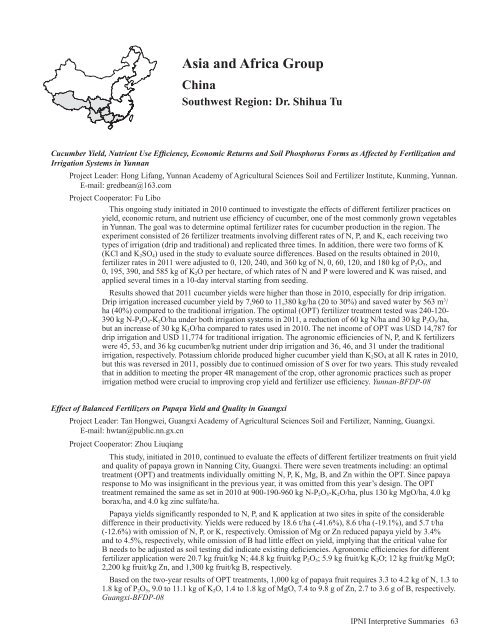Americas and Oceania Group - International Plant Nutrition Institute
Americas and Oceania Group - International Plant Nutrition Institute
Americas and Oceania Group - International Plant Nutrition Institute
Create successful ePaper yourself
Turn your PDF publications into a flip-book with our unique Google optimized e-Paper software.
Asia <strong>and</strong> Africa <strong>Group</strong><br />
China<br />
Southwest Region: Dr. Shihua Tu<br />
Cucumber Yield, Nutrient Use Efficiency, Economic Returns <strong>and</strong> Soil Phosphorus Forms as Affected by Fertilization <strong>and</strong><br />
Irrigation Systems in Yunnan<br />
Project Leader: Hong Lifang, Yunnan Academy of Agricultural Sciences Soil <strong>and</strong> Fertilizer <strong>Institute</strong>, Kunming, Yunnan.<br />
E-mail: gredbean@163.com<br />
Project Cooperator: Fu Libo<br />
This ongoing study initiated in 2010 continued to investigate the effects of different fertilizer practices on<br />
yield, economic return, <strong>and</strong> nutrient use efficiency of cucumber, one of the most commonly grown vegetables<br />
in Yunnan. The goal was to determine optimal fertilizer rates for cucumber production in the region. The<br />
experiment consisted of 26 fertilizer treatments involving different rates of N, P, <strong>and</strong> K, each receiving two<br />
types of irrigation (drip <strong>and</strong> traditional) <strong>and</strong> replicated three times. In addition, there were two forms of K<br />
(KCl <strong>and</strong> K 2 SO 4 ) used in the study to evaluate source differences. Based on the results obtained in 2010,<br />
fertilizer rates in 2011 were adjusted to 0, 120, 240, <strong>and</strong> 360 kg of N, 0, 60, 120, <strong>and</strong> 180 kg of P 2 O 5 , <strong>and</strong><br />
0, 195, 390, <strong>and</strong> 585 kg of K 2 O per hectare, of which rates of N <strong>and</strong> P were lowered <strong>and</strong> K was raised, <strong>and</strong><br />
applied several times in a 10-day interval starting from seeding.<br />
Results showed that 2011 cucumber yields were higher than those in 2010, especially for drip irrigation.<br />
Drip irrigation increased cucumber yield by 7,960 to 11,380 kg/ha (20 to 30%) <strong>and</strong> saved water by 563 m 3 /<br />
ha (40%) compared to the traditional irrigation. The optimal (OPT) fertilizer treatment tested was 240-120-<br />
390 kg N-P 2 O 5 -K 2 O/ha under both irrigation systems in 2011, a reduction of 60 kg N/ha <strong>and</strong> 30 kg P 2 O 5 /ha,<br />
but an increase of 30 kg K 2 O/ha compared to rates used in 2010. The net income of OPT was USD 14,787 for<br />
drip irrigation <strong>and</strong> USD 11,774 for traditional irrigation. The agronomic efficiencies of N, P, <strong>and</strong> K fertilizers<br />
were 45, 53, <strong>and</strong> 36 kg cucumber/kg nutrient under drip irrigation <strong>and</strong> 36, 46, <strong>and</strong> 31 under the traditional<br />
irrigation, respectively. Potassium chloride produced higher cucumber yield than K 2 SO 4 at all K rates in 2010,<br />
but this was reversed in 2011, possibly due to continued omission of S over for two years. This study revealed<br />
that in addition to meeting the proper 4R management of the crop, other agronomic practices such as proper<br />
irrigation method were crucial to improving crop yield <strong>and</strong> fertilizer use efficiency. Yunnan-BFDP-08<br />
Effect of Balanced Fertilizers on Papaya Yield <strong>and</strong> Quality in Guangxi<br />
Project Leader: Tan Hongwei, Guangxi Academy of Agricultural Sciences Soil <strong>and</strong> Fertilizer, Nanning, Guangxi.<br />
E-mail: hwtan@public.nn.gx.cn<br />
Project Cooperator: Zhou Liuqiang<br />
This study, initiated in 2010, continued to evaluate the effects of different fertilizer treatments on fruit yield<br />
<strong>and</strong> quality of papaya grown in Nanning City, Guangxi. There were seven treatments including: an optimal<br />
treatment (OPT) <strong>and</strong> treatments individually omitting N, P, K, Mg, B, <strong>and</strong> Zn within the OPT. Since papaya<br />
response to Mo was insignificant in the previous year, it was omitted from this year’s design. The OPT<br />
treatment remained the same as set in 2010 at 900-190-960 kg N-P 2 O 5 -K 2 O/ha, plus 130 kg MgO/ha, 4.0 kg<br />
borax/ha, <strong>and</strong> 4.0 kg zinc sulfate/ha.<br />
Papaya yields significantly responded to N, P, <strong>and</strong> K application at two sites in spite of the considerable<br />
difference in their productivity. Yields were reduced by 18.6 t/ha (-41.6%), 8.6 t/ha (-19.1%), <strong>and</strong> 5.7 t/ha<br />
(-12.6%) with omission of N, P, or K, respectively. Omission of Mg or Zn reduced papaya yield by 3.4%<br />
<strong>and</strong> to 4.5%, respectively, while omission of B had little effect on yield, implying that the critical value for<br />
B needs to be adjusted as soil testing did indicate existing deficiencies. Agronomic efficiencies for different<br />
fertilizer application were 20.7 kg fruit/kg N; 44.8 kg fruit/kg P 2 O 5 ; 5.9 kg fruit/kg K 2 O; 12 kg fruit/kg MgO;<br />
2,200 kg fruit/kg Zn, <strong>and</strong> 1,300 kg fruit/kg B, respectively.<br />
Based on the two-year results of OPT treatments, 1,000 kg of papaya fruit requires 3.3 to 4.2 kg of N, 1.3 to<br />
1.8 kg of P 2 O 5 , 9.0 to 11.1 kg of K 2 O, 1.4 to 1.8 kg of MgO, 7.4 to 9.8 g of Zn, 2.7 to 3.6 g of B, respectively.<br />
Guangxi-BFDP-08<br />
IPNI Interpretive Summaries 63

















